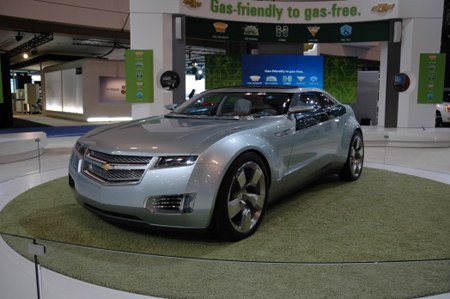General Motors Death Watch 174: Gravity Sucks
As a child I loved to play on swings. Leaning back and kicking my legs forward, I could propel myself into momentary weightlessness. Of course, every good swing ended with an acrobatic dismount. At the point of greatest forward momentum, I would let go of the chains and launch myself off the seat. For a brief moment I would be flying. Like an astronaut on NASA’s vomit comet, I would arc across the back yard. The sensation was thrilling. But I wasn’t a bird. Gravity’s hand never failed to pull me back to earth. And so it is with General Motors.
Today, The General defies gravity. Officially. The global automaker flies near the top of the newly released Fortune 500 list. Corporate revenues of $182b earned GM the number four spot (down one position) on Fortune Magazine’s Fortune 500, trailing only Wal-Mart Stores, Exxon Mobil, and Chevron. As Borat would say, “High five.”
What’s more, General Motors also scored on the list of The World’s 50 Most Innovative Companies. Collaboratively produced by BusinessWeek (BW) and the prestigious Boston Consulting Group (BCG), GM took eighteenth spot on this tally of cutting edge companies. Unlike the Fortune 500, which is strictly a measure of revenue, the BW-BCG list is based on the survey of 2,950 “senior executives” (weighted 80 percent), records of three-year margin growth and revenue growth (5 percent each), and three-year stock returns (10 percent).
GM, who BW dubs a “dark horse,” must have killed on the executive survey because their financials suck. (More on that later.) Fifty-five percent of survey respondents cited General Motors’ products as their most distinguishing innovation (as opposed to innovative customer experience, processes, or business model).
Clearly, the tens of millions (not to say billions) of dollars The General’s spent greenwashing its image has successfully advanced the automaker’s high tech rep within the business community’s chattering classes. One thinks specifically of GM’s highly-promoted, oft-delayed, completely unproven, Prius-chasing gas – electric Chevrolet Volt. And then of GM’s Green Car of the Year Award-winning dual-mode hybrid SUVs. But not specifically of anything actually selling in any number.
I’m at a loss to explain how GM ranks eighteenth of fifty overall behind Toyota ( Tata Group ( BMW ( and Honda ( while it is second on the top ten list of innovative automakers produced from the same data by BW-BCG. On that list, GM trail Toyota but edges-out Tata, BMW and Honda. Go figure.
Nonetheless, let us imagine GM flying through the air like a boy slung from a swing, intoxicated by the sweet air of high praise and honor. Now picture a speeding Chevy Aveo slamming into the unyielding off-set crash barrier at the Insurance Institute for Highway Safety. Let’s call that wall GM’s financial report.
During 2007, General Motors suffered $39 b-b-b-b-billion in losses. Among the Fortune 500, GM takes first place in that metric (or last place, depending on how you look at it). Earnings per share fell $68.45, revenue fell twelve percent and assets shrunk $26b.
In fact, General Motors is the only company in the Fortune top ten that lost money, save FoMoCo (who lost a paltry $2.7b). Even the two banks that cracked Forbes’ top ten– Citigroup and Bank of America– managed to turn tidy profits. This despite the ravaging impact of the well-publicized sub-prime mortgage loan losses. To top that off, from 2004 to 2007, GM stock returns slumped eleven percent.
If that number doesn’t put things in proper perspective, consider that General Motors lost nearly as much as Exxon Mobil made ($40.6b). Combine GM’s losses to those of GMAC ($2.3b)– which The General mostly and wisely unloaded during the year– and GM’s losses would have eclipsed the most profitable company in the world.
Unfortunately, conditions in 2008 are no better than ’07. Near-bankrupt suppliers continue to threaten disruption to GM’s manufacturing plants. Commodities market speculation is driving oil and gasoline prices to new highs, and GM has no credible economy car for the vital U.S. market. The American economy continues to flag and consumers are buying fewer new cars. E85, in which GM is so deeply invested, is fast emerging as an eco-fraud and the Volt’s got no batteries. The labor unions are proving that they will yield no quarter so long as the General has a dollar in the bank, no matter how fast their cash is burning up.
Couldda, shouldda, wouldda. Things would certainly be different today if corporate management had started hopping with their new found sense of urgency, say, ten years ago. Or twenty. Or thirty. Can General Motors get its feet back under itself before it hits the ground or are they going to land squarely on their head? Either way, despite this week’s headlines, the company is in a financial free fall and it’s going to hit the ground.
More by William C Montgomery
Latest Car Reviews
Read moreLatest Product Reviews
Read moreRecent Comments
- Probert They already have hybrids, but these won't ever be them as they are built on the modular E-GMP skateboard.
- Justin You guys still looking for that sportbak? I just saw one on the Facebook marketplace in Arizona
- 28-Cars-Later I cannot remember what happens now, but there are whiteblocks in this period which develop a "tick" like sound which indicates they are toast (maybe head gasket?). Ten or so years ago I looked at an '03 or '04 S60 (I forget why) and I brought my Volvo indy along to tell me if it was worth my time - it ticked and that's when I learned this. This XC90 is probably worth about $300 as it sits, not kidding, and it will cost you conservatively $2500 for an engine swap (all the ones I see on car-part.com have north of 130K miles starting at $1,100 and that's not including freight to a shop, shop labor, other internals to do such as timing belt while engine out etc).
- 28-Cars-Later Ford reported it lost $132,000 for each of its 10,000 electric vehicles sold in the first quarter of 2024, according to CNN. The sales were down 20 percent from the first quarter of 2023 and would “drag down earnings for the company overall.”The losses include “hundreds of millions being spent on research and development of the next generation of EVs for Ford. Those investments are years away from paying off.” [if they ever are recouped] Ford is the only major carmaker breaking out EV numbers by themselves. But other marques likely suffer similar losses. https://www.zerohedge.com/political/fords-120000-loss-vehicle-shows-california-ev-goals-are-impossible Given these facts, how did Tesla ever produce anything in volume let alone profit?
- AZFelix Let's forego all of this dilly-dallying with autonomous cars and cut right to the chase and the only real solution.


































Comments
Join the conversation